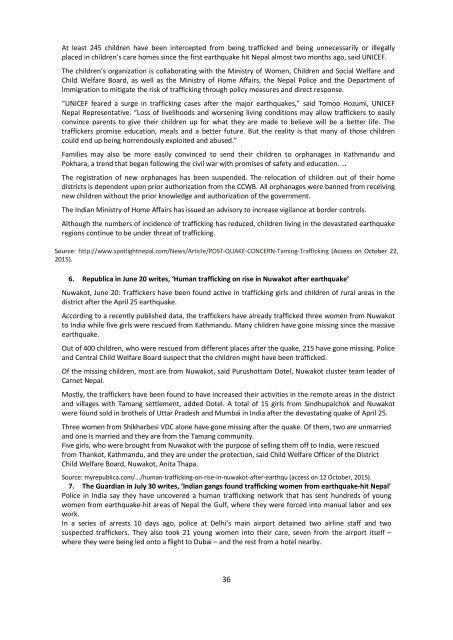TRAFFICKING IN PERSONS
1Spfyta
1Spfyta
You also want an ePaper? Increase the reach of your titles
YUMPU automatically turns print PDFs into web optimized ePapers that Google loves.
Box 3.1 Key issues and concerns<br />
Key issues<br />
Loss of houses<br />
Destruction of school<br />
Health and hygiene<br />
Description<br />
‘Our houses have been destroyed’<br />
‘We are living in a tent and cannot sleep at night’<br />
‘We have no space or privacy’<br />
‘Our shelter cannot stand up to the storms’<br />
‘We do not know when we will have a new house’<br />
‘We cannot go back to school’<br />
‘We are scared to go back to school’<br />
‘Our school materials have been destroyed’<br />
‘We are finding it difficult to study’<br />
‘We do not have safe drinking water’<br />
‘Toilets have been destroyed’<br />
‘We are getting sick’<br />
‘We do not have access to health care’<br />
Source: summarized from the study of Plan Nepal, Save the Children, UNICEF and World Vision (2015)<br />
The study established the impact of earthquake on children’s wellbeing, protection and future.<br />
Children are basically found to be: i) in grief and sadness at deaths of family members, friends and<br />
acquaintances; ii) they have strong feelings of loss, fear and other psychosocial impacts of the<br />
damage and destruction; iii) they also reported that their domestic and other chores increased; iv)<br />
concerns about not having adequate food and v) concerns about increased risks of abuse and<br />
exploitation were also raised.<br />
Children, especially girls reported that they are afraid of abuse and exploitation at the tents. This is<br />
because they are sharing shelters with extended families and community people. In several FGDs,<br />
the study team found that children were increasingly feeling vulnerability to sexual abuse,<br />
harassment and trafficking. For example, ‘in Bhaktapur girls referred to being touched and having to<br />
sit on the laps of drunken men; in Gorkha, girls referred to being pinched and sexually harassed in<br />
their tents; and in Nuwakot some girls reported that their names had been put on lists for Indian<br />
schools and that they were afraid of being trafficked’. The feeling of insecurity can be generalized<br />
from the following three children’s feeling:<br />
“Living under the sky increases our exposure to abuse.”<br />
– girl aged 16, Sindhupalchok<br />
“I don't like it when the adult men in the tent touch our cheeks.”<br />
– girl aged 8-12, Ramechhap<br />
“We should give priority to stop child trafficking and rape of those who are living in tents.”<br />
– girl aged 16-18, Sindhuli<br />
The study findings showed that the key priority and expectation for future for the children in postearthquake<br />
scenarios are i) having an earthquake protected home; ii) getting back to school; iii)<br />
access to clean water, sanitation and health care and iv) protection from all types of abuse, violence,<br />
exploitation and trafficking.<br />
3.4 Evidences of Trafficking of Women and Children after the Earthquakes<br />
Records of Nepal Police indicate that a total of 1,233 women and children were reported to be<br />
missing after the earthquake of April 25, 2015 to the end of September 2015 from across the<br />
country (Table 3.9). Among the recorded missing persons, a large majority are females (82%) while<br />
rest 18 percent are males. By age groups, 35 percent are children while the rest 65 percent were<br />
adult women. The highest percent of the missing children and women recorded is in Kathmandu<br />
valley (28%), followed by Pokhara (26%).<br />
38


